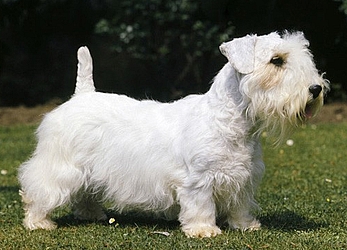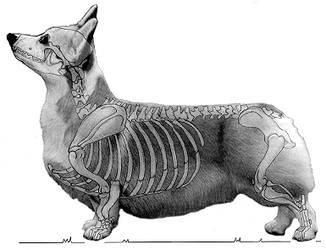By Tom Horner
A breeder of one of the more recently recognised short-legged terrier breeds has written asking for help in improving the conformation and thereby the movement of his breeding stock.

Sealyham Terrier
He bought his first example of the breed as a pet, to be told by an experienced breeder that it had such a good head it would be sure to win a lot if it were shown. This breeder encouraged the owner to show it, and also helped with its presentation. The breeder's forecast came true and the dog won quite often but was usually placed second or third and almost always had its front and front movement criticised.
The owner was advised to obtain a well built bitch with a really good front to mate with his good headed male. This resulted in puppies with better fronts but none as good as their dam in that feature, nor quite as good as their sire in the head. The breeder has written to ask how he can set about breeding stock with correct fronts without losing the original dog's head quality.
This is a knotty problem which bothers a great many breeders of the short legged breeds. In all these breeds, good sound free moving fronts depend on getting the bone structure right for each particular breed.

Cardigan Welsh Corgi |

Pembroke Welsh Corgi |
All short legged breeds have shorter shoulder blades and upper arms than the taller breeds, but in every short legged breed there must be sufficient length in their shoulder blades and upper arms to enable those parts of their forehands to form a very marked angle between them. In most breeds of this kind a right angle or very close to 90 degrees is the ideal.
This is essential if the bearers are to be able to move freely and soundly in front - that is with the forelegs turning neither in nor out and the dog striding out well in front and the feet not leaving the ground until well past the elbows as the dog moves forward.

©Béatrice Quinio |

©PWCCA - Courtesy Stephanie S. Hedgepath |
In addition to having a good length, the shoulder blades must be well laid back and inclined towards each other on the ribcage. The upper arms must also be well laid back and held closely on the ribcage, but with sufficient freedom to reach well forward and back. This cannot be achieved without sufficient length in these bones.
The actual shape of the forehands of many of the low to ground breeds varies considerably, but all should have both their shoulder blades and upper arms firmly attached by good muscling to the ribcage, but at the same time freedom to move forward and back without the feet pointing out of line or the elbows protruding.
Achieving and maintaining good heads and good forehands is not an easy project to achieve if one or other is faulty in your breeding stock. Aiming high and never using any but first rate stock, especially stud dogs, is as good a method as any.
The breeder could perhaps concentrate on improving one feature for a generation or two and then on the other - such a method with strong selectiveness and never breeding together a dog and bitch with the same fault or weakness should at least maintain the good properties and hopefully will improve the faulty ones. With a bit of luck some top quality stock should soon be achieved. Using stock that is linebred and has the points you want is the ideal method, if such stock can be found.
Reproduced by Dog World online
21/10/2015 by Simon Parsons
Abridged by Anita Nordlunde:
Paragraphs not relevant for corgis have been left out.
13.04.2021
